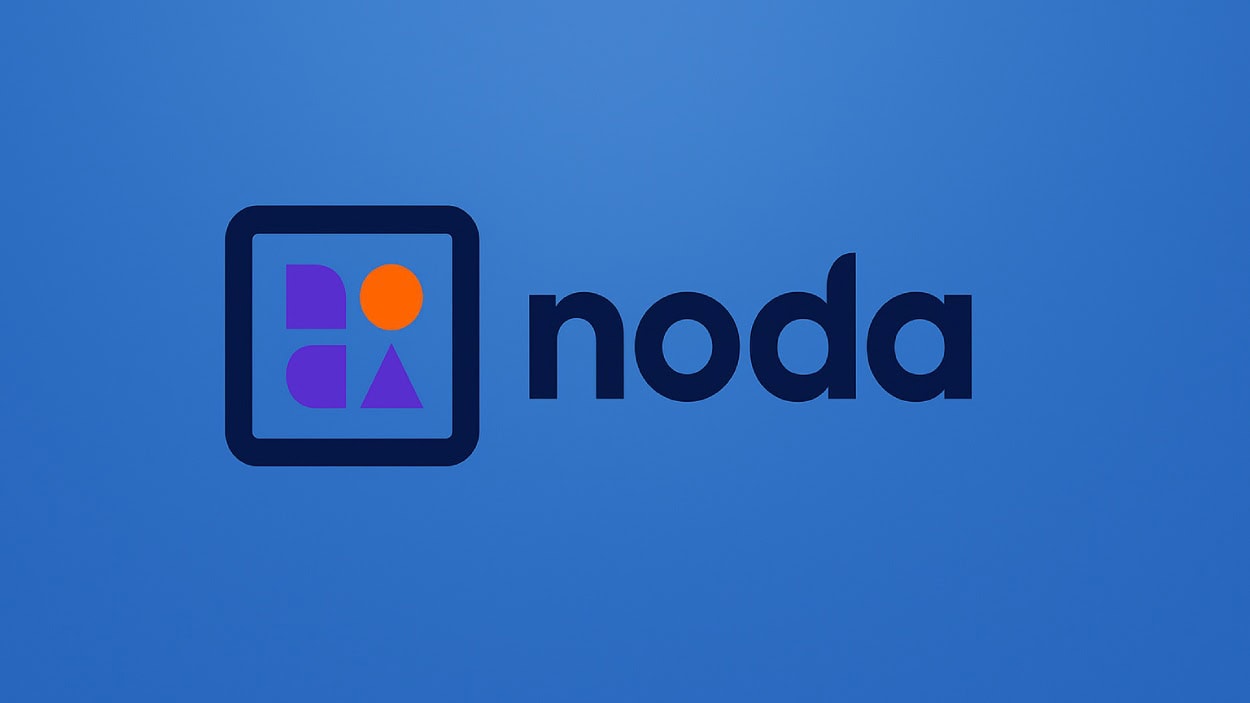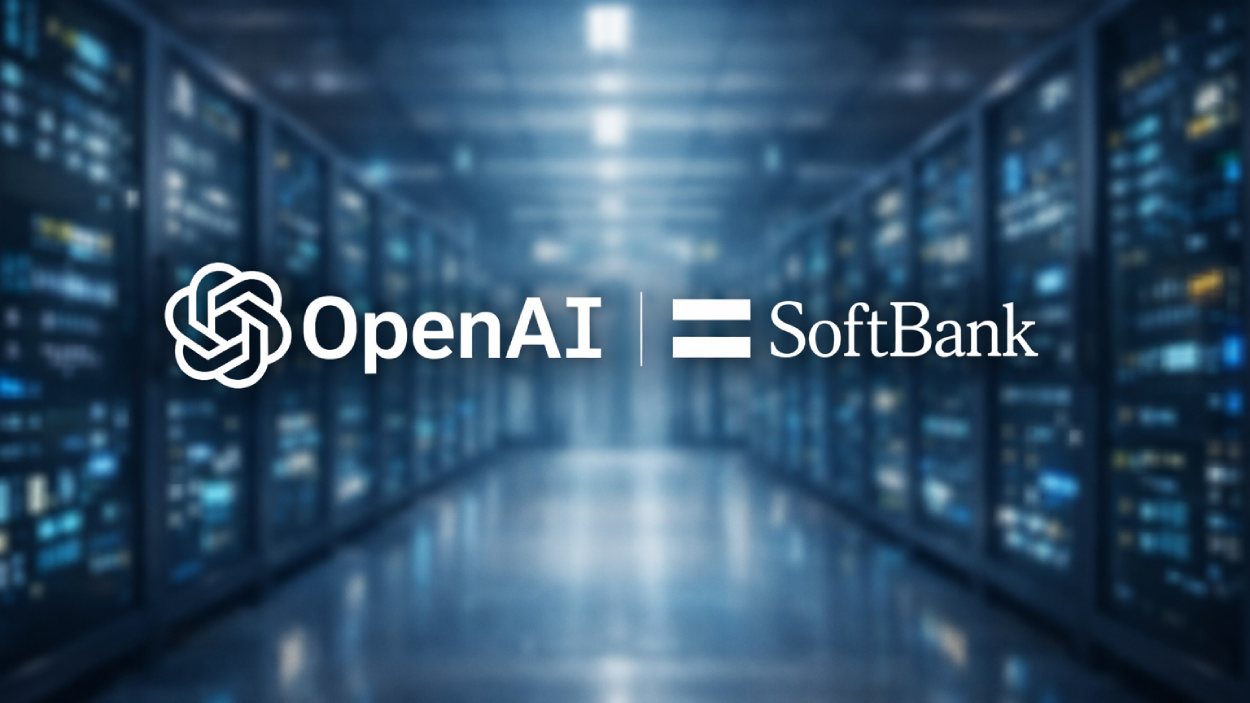Ahrefs remains a cornerstone in SEO research and strategy, offering deep insights into web content and search performance. Its data powers decision-making across digital marketing and competitive analysis, from content creators refining keyword strategy to enterprises optimizing backlink outreach. Explore the figures below to grasp how Ahrefs shapes SEO.
Editor’s Choice
- Ahrefs generated $149.1 million in annual revenue by 2024.
- As of March 2025, Ahrefs reports over 27.2 trillion internal backlinks indexed, a 112.5% increase since 2017, according to internal estimates
- Indexed domains climbed to 267.6 million by March 2025, a 24.87 % boost from late 2024.
- Pages indexed reached 456.5 billion, up 12.94 % since early 2025.
- External backlinks soared from 3.3 trillion in 2022 to 35 trillion in 2025, a 960.61 % increase.
- Ahrefs’ keyword database grew from 20.8B in 2024 to 28.7B by March 2025, a 38% increase according to tracking data shared by the company.
- Ahrefs supports 13 languages as of March 2025.
Recent Developments
- Ahrefs’ infrastructure comprises 3,600 servers with 691K CPU cores, 4PB of RAM, and nearly 500PB of SSD, as detailed in their public updates.
- It crawls approximately 10 million new pages daily, up 233.33 % from 2022’s 3 million.
- It updates metrics for 300 million pages every 24 hours, a 25 % rise over 2022.
- Ahrefs’ custom-built “Yep1” supercomputer processes SEO data at 23.32 petaflops, reportedly placing it among the top 50 globally.
- AhrefsBot ranks as the most active SEO crawler on Cloudflare Radar and the second most active crawler globally.
How Many Pages Are Created/Assisted with AI
- 25.8% of web pages are created by pure human effort with no AI involvement.
- Only 2.5% of pages are generated entirely by pure AI.
- 9.87% of pages show minimal AI use (1–10%).
- 46.36% of pages rely on substantial AI use (11–70%).
- 15.51% of pages are built with dominant AI use (71–99%).
- In total, 71.7% of web pages are now created through a Human + AI collaboration.
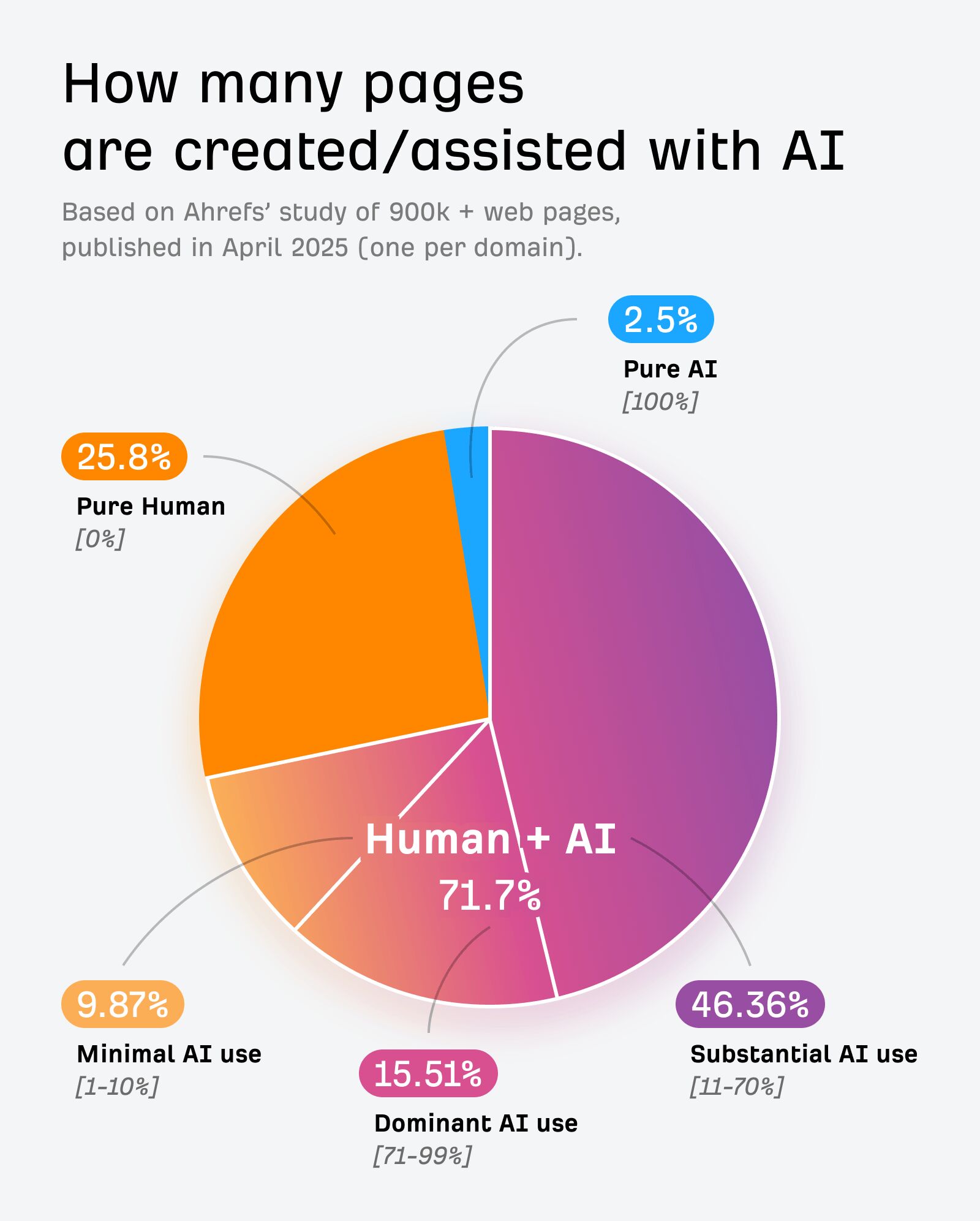
User Growth Statistics
- Ahrefs reached US$149.1 million in annual revenue by 2024, growing from approximately US$1 million in 2011.
- Startup users (0–9 employees) make up 40.99 % of the customer base as of March 2025.
- Companies with 20–49 employees account for 24.60 %.
- In March 2025, U.S.-based users made up about 60% (23,695) of Ahrefs’ customer base, according to internal user distribution data.
- Ahrefs added 20,113 new users in a single week during April 2025, based on signup statistics cited in marketing disclosures.
Database Size Statistics
- Ahrefs has indexed 456.5 billion pages as of March 2025, a 12.94% rise since early 2025, based on infrastructure metrics.
- It indexes 267.6 million domains, up 24.87 % from late 2024.
- Its keyword database covers 28.7 billion keywords, up 37.98 % from 20.8 billion in 2024.
- The U.S. keyword database alone holds 2 billion keywords.
- Ahrefs covers 226–217 regions, the most among SEO tools.
Prevalence of SERP Features
- Related Searches appear most often, showing up in 85.15% of results.
- Reviews are present in 79.12% of SERPs, making them a highly influential feature.
- Videos are found in 78.38% of search results, highlighting the importance of multimedia.
- People Also Ask sections appear in 64.24% of SERPs.
- Image Blocks show up in 45.39% of search results.
- Standalone Images are included in 35.49% of SERPs.
- Shopping Results are visible in 15.19% of queries.
- Discussions and Forums appear in 14.39% of SERPs, reflecting user-generated content.
- Featured Snippets are found in 10.47% of results.
- The Knowledge Graph has minimal representation compared to other SERP features.
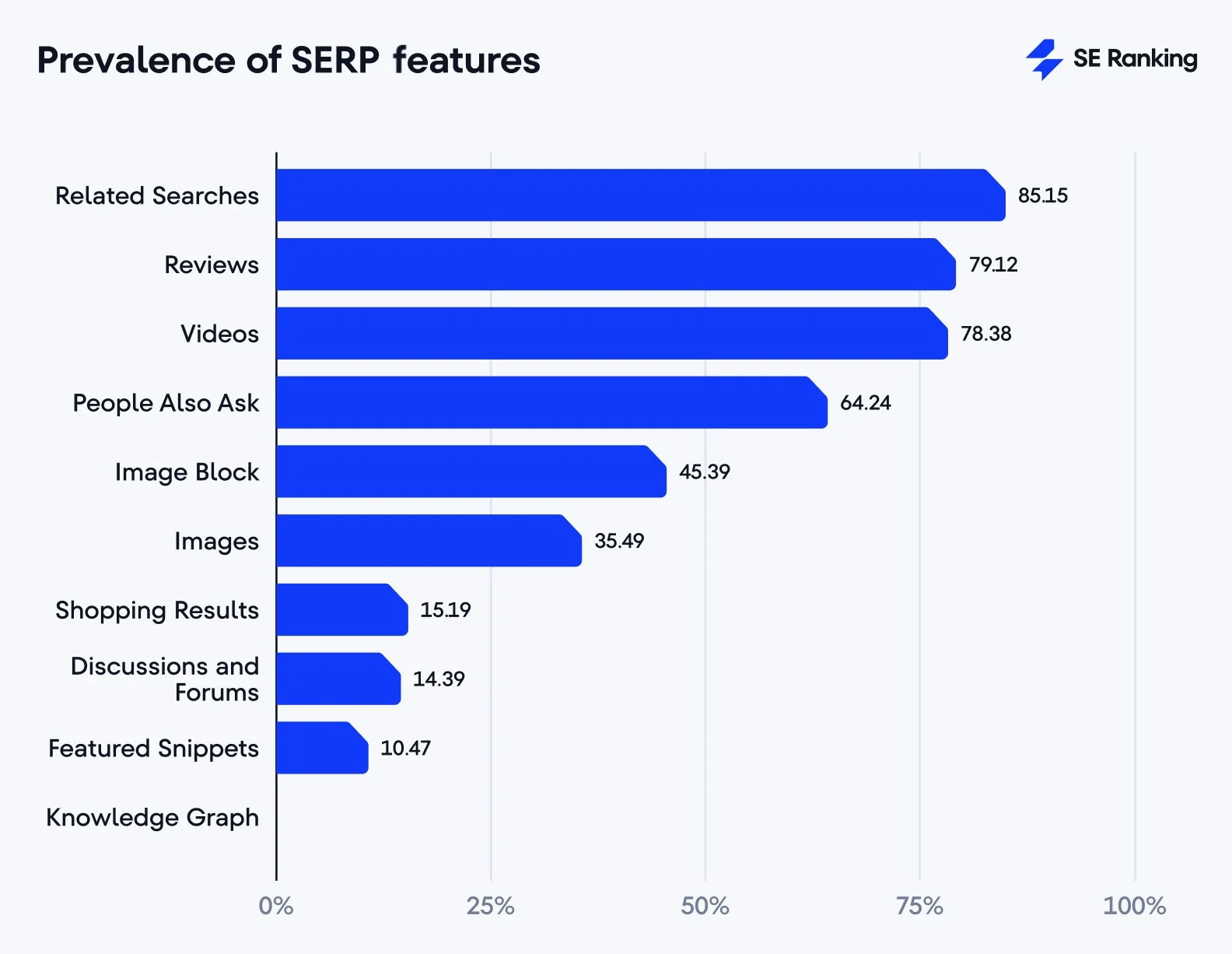
Backlink Index Statistics
- Internal backlinks rose to 27.2 trillion as of March 2025, a 112.5 % increase since 2017.
- From 2022 to 2025, Ahrefs’ external backlink index expanded from 3.3 trillion to 35 trillion, a reported 960%+ increase in scope.
Keyword Index Statistics
- The total keyword database expanded to 28.7 billion keywords in March 2025, up 37.98 % from the previous year.
- That figure represents just 26.09 % of the total 110 billion keywords Ahrefs holds, the filtered, actionable subset.
- The U.S. holds 2.2 billion of these keywords.
Site Audit Statistics
- Ahrefs’ Site Audit tool scans over 170 SEO issues, covering everything from duplicate content to Core Web Vitals and structured data.
- It handles more pages per project, between 25K and 250K, versus Semrush’s 20K–100K.
- Always-on audits and IndexNow integration enable faster detection and resolution of technical issues.
- New in April 2025, Ahrefs launched real‑time Site Audit reporting with continuous crawls for near-immediate issue detection.
- Missed issues are minimized thanks to live SEO fixes, allowing corrections to be made directly in the dashboard.
- Site Audit classifies issues into errors, warnings, and notices, with clear visual prioritization.
- It includes JavaScript rendering in all plans, unlike some competitors that restrict this to higher tiers.
- Ahrefs’ real-time reporting ensures a faster feedback loop for technical SEO improvements.
How Long Does SEO Take?
- 11% of respondents said SEO results take 1–2 months.
- The majority, 58%, reported it takes 3–6 months to see results.
- 19% noted that SEO progress shows in 7–12 months.
- 12% indicated it may take over 12 months to achieve meaningful outcomes.
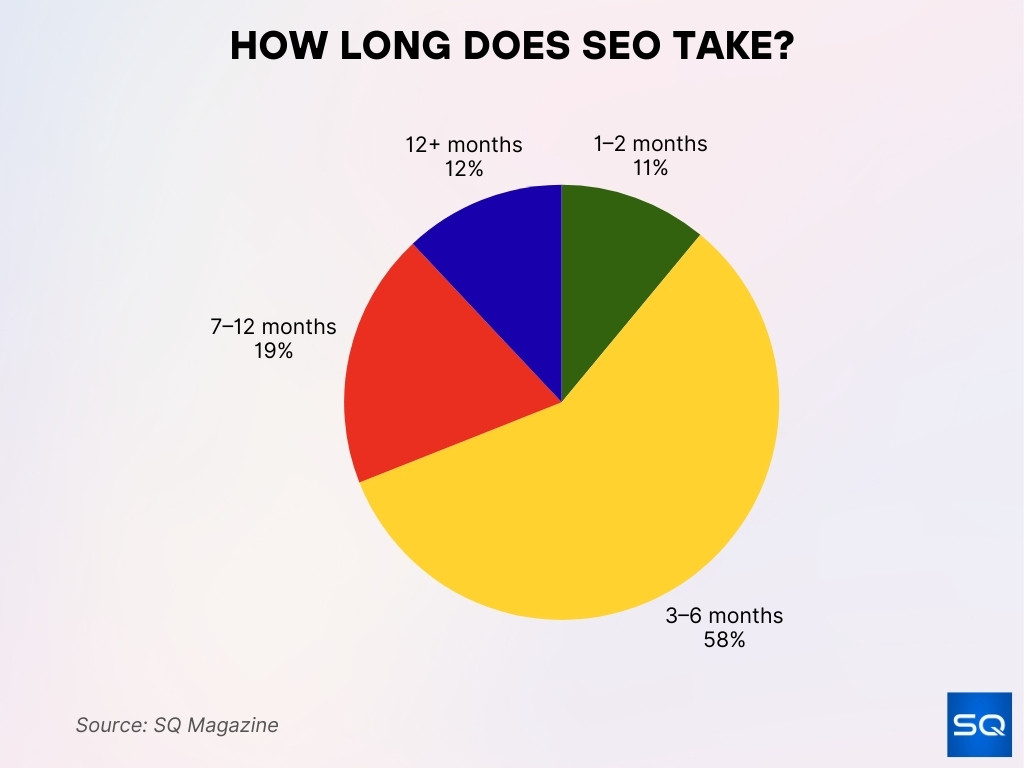
Traffic Analysis Statistics
- Ahrefs.com saw approximately 25.3 million site visits in May 2025.
- Earlier data, traffic rose from 11.9 million in February to 12.3 million in March, before dipping to 10.4 million in April.
- On average, Ahrefs sustains a steady mid‑month traffic of around 2.27 million weekly visits, outperforming Semrush.
- U.S. visitors account for roughly 18.77% of Ahrefs.com’s total traffic, per third-party analytics tools like Similarweb, reflecting an 11% recent decline.
- Ahrefs consistently beats Semrush on traffic steadiness and weekly engagement.
- Its persistent domain coverage and backlink depth likely fuel this performance.
Content Explorer Statistics
- Ahrefs’ Content Explorer remains a go-to for content discovery across multiple domains.
- Users can search topics and filter by traffic, backlinks, and referring domains.
- It supports analysis of new content trends and competitive performance.
- Deep filtering enables drilling down by content type, domain rating, or publication date.
- Features help identify high-traffic content and emerging thematic gaps.
- Its integration with other Ahrefs tools, Keyword Explorer, and Site Explorer, boosts research workflows.
- Many marketers rely on it to pinpoint “evergreen” or trending articles to inform their content strategy.
Top Linked Domains
- In AI-generated Overviews across 76.7 million prompts, Wikipedia leads domain mentions, capturing up to 16.3% share.
- YouTube ranks high in Perplexity (16.1%) and AI Overviews (9.5%) as a cited domain in Brand Radar data.
- Reddit (7.4%) and Quora (3.6%) appear prominently in AI Overviews.
- News outlets like Reuters and AP (Apple News) show up in ChatGPT’s top-cited domains (2.6% share).
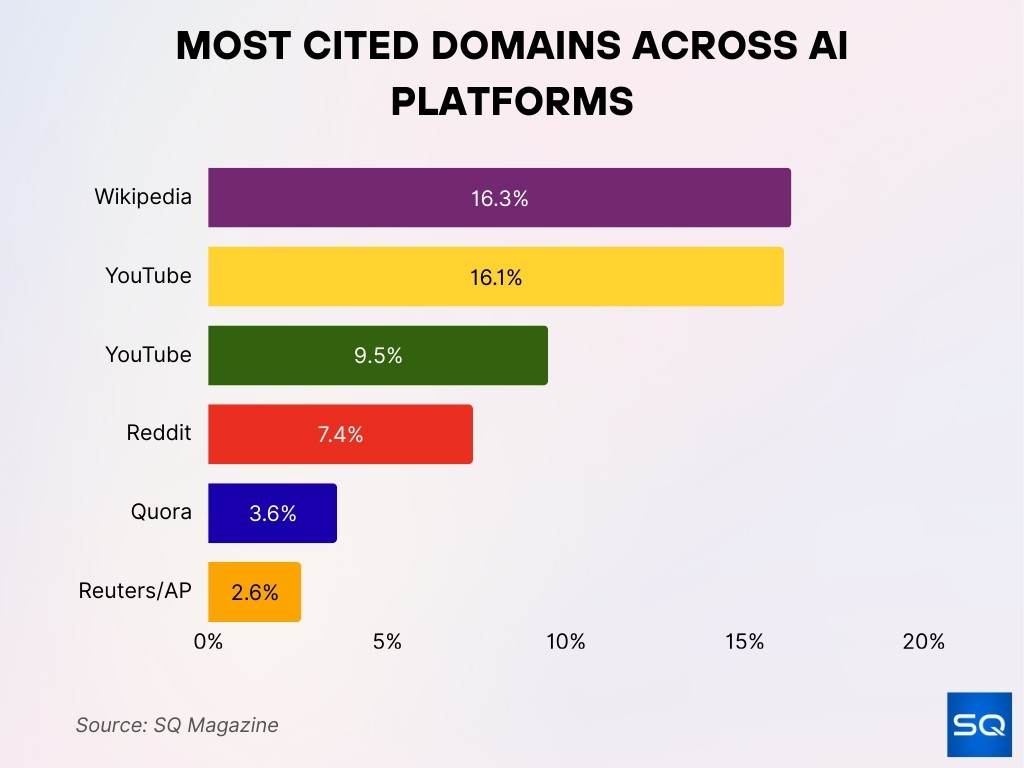
- Among the top‑50 domains cited across AI assistants, only 14% appear consistently across all platforms.
- Off‑site brand signals, such as web mentions and anchor usage, correlate more strongly with AI visibility than backlinks.
- Brands ranking #1 in Google traditional results have a 25% chance of being used as sources in AI Overviews.
Rank Tracking Statistics
- In April 2025, Ahrefs unveiled Rank Tracker 2.0, a rebuilt backend for faster, more stable performance.
- It now supports bulk editing, allowing users to add, delete, or filter hundreds of keywords at once.
- You can now compare SERP overviews over time and use the “Identify intents” feature to spot shifts in search intent.
- The revamped interface streamlines rank monitoring with real-time updates and greater flexibility.
- Rank Tracker continues integration with other Ahrefs tools, maintaining a unified dashboard experience.
- These enhancements make tracking SEO outcomes both faster and more strategic.
Crawler Statistics
- AhrefsBot scans over 8 billion pages every 24 hours, ranking top among SEO crawlers.
- It refreshes its index every 15–30 minutes, ensuring freshness and relevance.
- Ahrefs operates extensive infrastructure, 3,600 servers, 694K CPU cores, 4 PB RAM, 32 PB HDD, and 505 PB SSD storage.
- Between 2022 and 2025, server count increased by 68.93%, up from 2,131 to 3,600 units.
- The crawler’s capacity supports both deep web coverage and rapid updates.
- Its scale underpins the massive indices Ahrefs maintains.
API Usage Statistics
- Ahrefs offers APIs for data retrieval across metrics, backlinks, keyword volume, rankings, and site audits.
- Many agencies integrate the Ahrefs API into dashboards or BI tools for automated reporting.
- API clients benefit from flexible access to Site Explorer, Rank Tracker, and Content Explorer data.
- High-end plans include generous API call limits to support bulk data processing.
- API access spans across multiple tools within Ahrefs’ ecosystem.
Most Searched Keywords
- The Ahrefs keyword index grew to 28.7 billion filtered keywords in 2025, only 26.09% of the full 110 billion.
- Key sources span 217 global locations and 10 search engines, including YouTube, Amazon, Bing, and Baidu.
- The U.S. alone holds approximately 2.2 billion of those keywords.
- Though granular “most searched” lists aren’t public, Ahrefs’ Keyword Explorer allows identification of top-volume keywords.
- The filtered index focuses on actionable, high‑value terms, making it ideal for SEO planning.
Competitive Analysis Statistics
- As of March 2025, Ahrefs had a 22.94% market share in SEO/SEM platforms, per third-party SaaS market data.
- Its customer base numbered 49,085 domains/customers, versus 118,406 for Google Ads.
- Ahrefs aids in identifying content gaps via its Content Gap feature.
- The Rank Tracker Competitors Overview includes Share of Voice, traffic trends, and SERP feature visibility.
- Tools like Best Links Report, Backlink Calendar, Lost Links Report, and DR/UR filters aid competitive analysis.
- A recent industry survey found 59.1% of SEO pros ranked Ahrefs as their preferred all-in-one tool, though sample size and source specifics were not published.
- 68.1% of users rated Ahrefs the most accurate and comprehensive provider of backlink data.
Organic Search Statistics
- Ahrefs’ organic search traffic index includes ~590 million keywords, of which 9.46% (≈55.8 million) generate AI Overviews.
- As of June 15, 2025, 12.8% of all search volume, ≈23 billion queries, is covered by AIOs.
- In the U.S., ~16% of keywords (24.9 million of 156 million) trigger AI Overviews.
- In July 2025, traffic to Ahrefs.com rose 13% month-over-month to reach 24.1M visits.
- Paid search traffic for Ahrefs totaled 40.32K visits in July 2025, a 16% month-over-month decline per digital ad analytics.
- Ahrefs’ main sources of onsite traffic are Direct (73.4%) and Google.com (17.7%).
- Its Authority Score stands at 77, with 4.54 million backlinks and 120.18K referring domains.
Paid Search Statistics
- As of July 2025, Ahrefs derived 40.32K visits from paid search, a drop of 16% month-over-month.
- Ahrefs’ strength remains in organic search and backlink depth, not in paid advertising traction.
Geographic Coverage Statistics
- In July 2025, U.S. users made up 17.05% (≈4.11M) of Ahrefs site visitors, followed by India (16.67%) and Indonesia (6.32%).
- Featured tools like Site Explorer provide traffic data for any country, spanning 171+ countries.
Conclusion
Ahrefs stands out as a leading SEO platform, backed by robust infrastructure, massive data coverage, and high user trust. Its unmatched backlink index, expansive keyword database, and insights into AI-generated search signals, like AIOs and Brand Radar, provide strategic visibility that few tools match. Whether you’re monitoring competitive landscapes, analyzing organic trends, or shaping AI-aware SEO strategies, Ahrefs delivers clarity and depth. Explore these stats and see how your strategies can leverage Ahrefs’ current footing in the SEO landscape.




















































